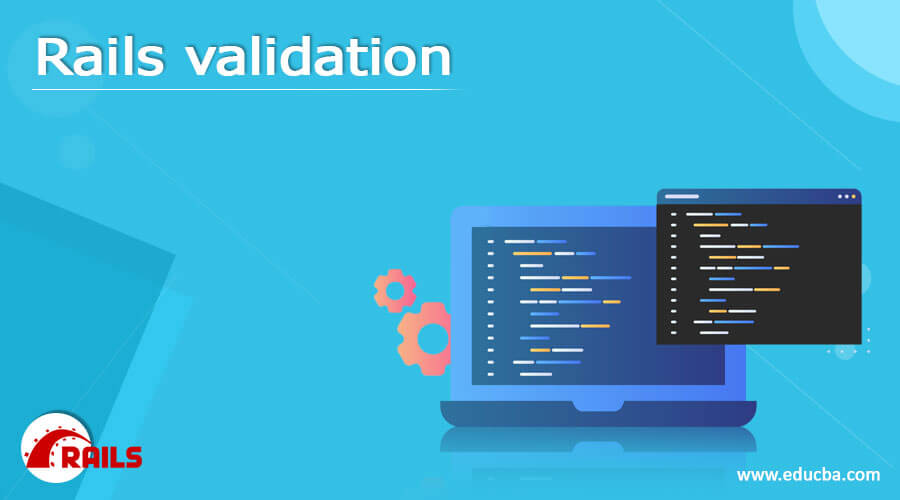Updated June 12, 2023
Definition of Rails validation
It is always necessary for anyone to check whether the entered data is valid or not. At a given point, checking the validation for the entered data is very important, and the kit can be achieved in ruby using the Rails validation method. The validity state can be checked using rails validation for a record model class. Various built-in validation methods are there in Ruby rails. Using the built-in validation DSL, we can do many types of validation. It is possible to create a user-defined validation method. Failure in the Active record model state is considered an error.
What is rails validation?
If we are entering some data in Ruby, we need to ensure whether the entered data belongs to the Active record state or not. We need the Rails validation term to ensure data validity and to say if the entered data is valid or invalid. When the object is unsaved, it states that an error has been created in Ruby. The validity key checks for its validity, and if it is true and no errors are found, its validity is checked; otherwise, it will show false. The one important application is that if we are mailing to someone, it helps to ensure that we are mailing to the right recipient. Additionally, it is important to know that we need to ensure that only needed data is saved in the database, which means we need to validate the data at the model level. There are three different validation methods, and each has its advantages and disadvantages; let us discuss them below.
1. Native database constraints: When we use rich content in the table, validation at the database level is needed. When we validate at this stage, the data can be handled safely. Also, it makes the testing and maintenance of huge data easier.
2. Client-side validation: When we maintain a site, then client-level validation can be found useful. Still, this has an advantage because when it is used alone using JavaScript, mostly validation will go unreliable. But this disadvantage can be overcome when they are used along with other techniques.
3. Controller level validation: This may be one of the tempting ways to use validation, but it has its disadvantage: it has difficulty in testing and maintenance. But in the long run, this validation method is really helpful.
Rails validation model
As far as we know, Rails is one of the very sophisticated frameworks, and it has many built-in facilities. Another great advantage of using Rails is that it provides an Active Record feature. As a result, rails in ruby are used to execute complex tasks more easily. For example, a validation feature checks the data for its duplication or originality. Active records are very significant in validating any data. It acts as a helper to validate if the entered data matches with the database on a string-matching basis.
Below is an example to explain the rails validation model:
# user.rb
class User < ApplicationRecord
has_many :posts, dependent: :destroy
validates :username, :password, :bibiogram, presence: true
endIn the above example, the attributes are separated by commas, and the keyword used is “validates.” Also, the validator is “presence,” and “true” is the condition assigned to the validator. The validator checks for the presence of an attribute or nil string.
Creating a custom method of rails validation
Now let us see how to create a user-defined validation method in ruby rails with an example.
# users_controller.rb
class UsersController < ApplicationController
def create
user = User.create(user_params)
if user.valid?
render json: {user: user}, status: :created
else
render json: {errors: user.errors.full_messages},
status: :not_acceptable
end
end
private def user_params
params.permit(:username, :password, :bio)
end
endTwo keywords should be used if the client needs to streamline the attributes. Are they valid? Method and render method. Also, user_params helps the client to streamline as per their wish. In the above example, we are using JSON and HTTP status, from which the client has built the application using this.
So, in the above example, the object is user_param, and the variable is the term user. When do we call the valid? Method on the user, and if the user is present successfully in the database, a transmission of status will be created along with a response from an object for the user. Different objects will be included in the JSON response if this doesn’t happen. Sometimes, the not acceptable status will also be included.
Rails validation example
To validate the data for its validity, we use a simple example to check if the entered data is valid (true) or invalid (false).
class Person < ActiveRecord::Base
validates :name, :presence => true
end
Person.create(:name => "Jonny").valid? # => true
Person.create(:name => nil).valid? # => falseIs the keyword valid? It Will initiate the search for validity, and if it finds the keyword exactly, it will say it as true; if not, it will return the value as false. No error should be present to return the statement as true. In the above example, if the Jonny name is present, it will validate it as true. As per the definition, if the collection is empty after completing the validation, the object is said to be valid; if not, it is invalid.
Conclusion
The Rails validation, used in the ruby framework, is one of the helpers to check if the data entered is valid or invalid. Is this validity checked by using the key term valid? And we have seen different types of validation. Importantly, we saw an example of a user-defined validation method. This validation key is really helpful for checking across many data entered. The main examples are to check for the validity of an email ID or to check for a particular character in a huge set of data in the database.
Recommended Articles
We hope that this EDUCBA information on “Rails validation” was beneficial to you. You can view EDUCBA’s recommended articles for more information.


